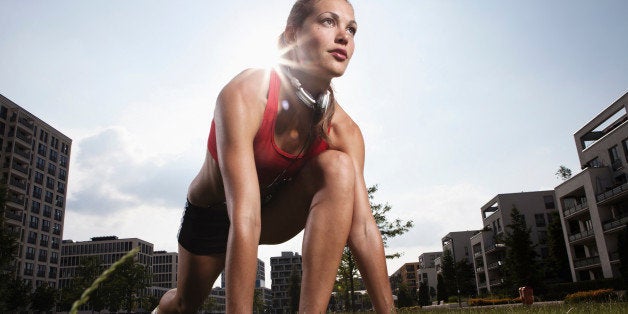
Stretching is an important aspect of any fitness routine and running is no exception. Stretching not only feels good after a run, it also helps to increase range of motion and muscular coordination. It can also help muscles recover faster and help you get from run to run with more ease.
Since running does put a lot of stress on the body, its good to have a few stretches in your arsenal that target the muscles you use most. Whether your new to stretching (or new to running), these five stretches will help you increase mobility, flexibility and recover faster run after run:
Twisted Pyramid Pose:
This pose is one of my all time favorites for getting a deep stretch into those pesky IT bands and ironing out kinks in your hamstrings.
- Stand at the top of your mat and step your right foot back about three feet.
- Place your hands on your hips and square them to the front.
- Keep both legs straight as you exhale your body (keeping a flat back) towards your front leg. Use a block if your hamstrings are especially tight.
- Once you're in Pyramid Pose, take a few deeps breaths to really soften into it.
- Keeping your feet still, move your right hand to the outside of your left foot and twist your torso to the left.
- Keep inching your right hand to the left and extend your left hand skyward. Breathe and hold.
- Repeat on other side.
Half Split:
Half splits are a great stretch for the hamstring, IT band and calf muscles. It also helps open up the hips and lower back.
- Come into a low lunge with your left leg in front.
- Exhale as you straighten your front leg as much as you can (it's ok to have a slight bend in your front leg). Use blocks under your hands for added support.
- Breathe into the pose allowing your hamstring to soften.
- Repeat on the other side.
Double Pigeon:
Double pigeon is a must for runners. It targets the hips and groin and also stretches the glutes and lower back.
- Begin seated with both legs extended straight out in front of you.
- Bend your right knee to approximately a 90-degree angle and bring the outer edge of your bent right leg to rest on the mat in front of you. Your right shin should be parallel to the front of the mat and the right foot should be flexed and active (foot should be perpendicular to your shin).
- Bend your left knee and pick up your left leg to stack it on top of your right. The idea would be to stack the shins directly on top of one another. Again, try and make sure your left foot is flexed and active (this will help protect your knees).
- Keep your fingertips on the mat beside your hips and draw your shoulder blades down your back.
- If you're OK moving a bit deeper, try taking your hands on the ground in front of your legs and walk yourself forward over your legs, trying to maintain a nice flat back.
- Hold for a few breaths and then repeat on the other side.
*If stacking the hips seems impossible, straighten your bottom leg out in front of you. If the legs are stacked but the knee is lifted uncomfortably high, use a blanket or bolster under the knee for support.
Seated Forward Fold:
Wide-legged seated forward fold is a great way to stretch the inner legs (which often get neglected), as well as hamstrings and groins, helping to open up the pelvis and lower body.
- Take your legs out as wide apart as you comfortably can, keeping feet flexed and active so the inner thighs don't collapse inwards. Kneecaps should point straight up toward the ceiling and heels should be rooting firmly into the ground.
- Place fingertips on the ground in front of you, just between your legs. Maintain the length along the spine, keep shoulders relaxed and chest open. Inhale.
- Exhale and slowly walk fingertips forward until you find an edge that feels appropriate for you. Avoid going too deep -- if your spine starts to round and shoulders collapse, back off!
- If it's comfortable, come down on palms, forearms or take your torso down onto the ground between your legs.
Dolphin Pose:
Dolphin pose help strengthen the body (most notably shoulders, arms, upper back and legs) while also lengthening the body (spine, hamstrings, calves and arches). If you have tight calves, this is a great way to relieve some tension after a run!
- Start on your hands and knees with your wrists directly under your shoulders and your knees directly under your hips.
- Lower your elbows to the floor directly beneath your shoulders and keep your forearms parallel to each other and to the side edges of your mat. Try to distribute the weight evenly across both forearms.
- Tuck your toes and lift your knees off the floor. Reach your hips up toward the ceiling.
- Straighten your legs, bringing your torso and legs into the shape of an "A."
- Gaze at your navel and hold for a few breaths.
Try these stretches at the end of a run (give yourself a few minutes to cool down first) and see if it helps your running performance and decreases your recovery time.